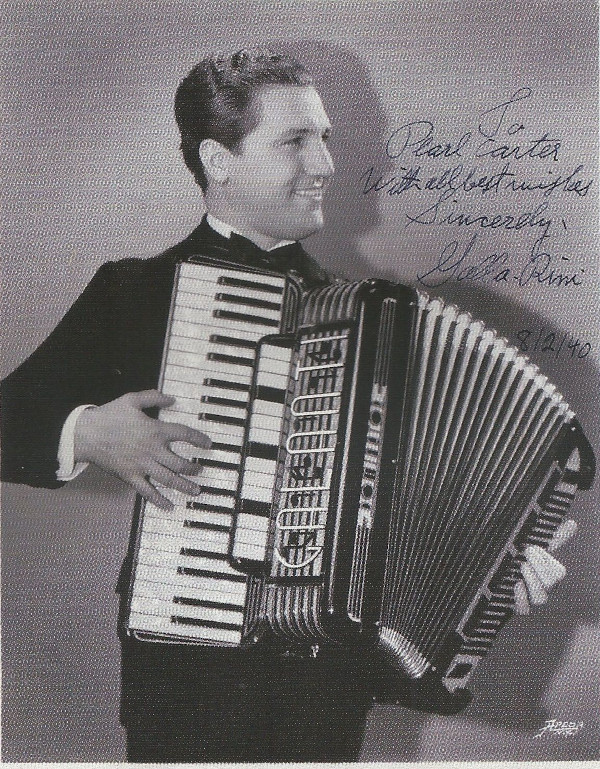The Accordion in the Serious Field of Music
by A. Galla-RiniNoted Accordion Virtuoso and Instructor


It has become more and more apparent that the accordion is beginning to be appreciated and accepted for its true musical value, wherever and whenever it is given the opportunity to be present in serious music, as well as selections in the lighter vein.
The concert stage has come to realize more fully that variety is the spice of life (and of the concert stage) and, already enriched with a sufficient number of great singers, pianists, violinists, choirs, etc., it can afford to cultivate the careers of serious accordionists and promote their concert appearances.
The harmonica has gained its recognition and acceptance on the concert stage by at least two outstanding artists. It would be just as appropriate for concert bureaus to include concert accordionists in their roster of artists. This is now coming to pass, gradually but surely.
The number of appearances of accordionists with symphony orchestras is also gaining momentum and a good part of this acceleration is due to the emergence of a number of concertos for accordion and orchestra which have been composed in recent years.
Moreover, the proteges of today (who took the intellectual musical approach to the accordion) are in the midst of writing originals in other various forms for concert use. While we are gaining in originals, yet still needing much more, there will always be the need for a number of skillfully-transcribed arrangements of good music, most carefully selected-- this to prove the musical legitimacy of the instrument. Within the past twelve years the progressive music publishers have taken great strides forward to supply us with this material, which is now published and available.
In speaking of the instrument itself, despite the production hold-up imposed on it during the entire war period, accordion interest between teacher and student has remained at a high level throughout. Since the end of the war, many new and finer models have been created and made available to the public, especially constructed for the exacting use of the concert stage.
I would like to point out especially that the accordion has the great advantage of rumming the gamut of all types of music in performance, with justice done to all if the performer plans his program carefully. There are not many other instruments that can offer this possibility of range in style and I sincerely believe the accordion has the best capabilities for it.
In the educational field, the accordion is being accepted in a gradual manner, at least from all indications. A number of teachers have caused the instrument to be accepted by Colleges and Universities as a part of their curriculum (also Conservatories). A letter I received a few days ago informs me that Trinity University in Texas now offers a major in accordion.
Along the more popular trend, it is also with satisfaction that we find the accordion used more and more in dance bands, night clubs (as entertainers or strollers), cocktail rooms, theatre lobbies, etc. Many small combos have come to the fore, wherein the accordion again shows its versatility. The attention of the swing enthusiasts has been drawn towards the accordion as and exponent of this type of music, due to the expert styling of many outstanding artists who are coming into their own today.
While the formulation of promotional plans has not been within my scope of experience, since my activities have been purely professionals, I believe, however, that dealers can look forward to increased accordion activities that will be everlasting if the promotional plans they adopt do not exclude, but rather include, (or at least be complemented by) the following activities in prescribed manner:
(1) While elementary approach is easy on the accordion, student and public in general should be informed they can advance as far, musically and professionally speaking, as on any other instrument, if they apply themselves.Too much attention has been paid to low retail prices and, especially, to large discounts. Displaying a high caliber of musical stock will help the cause and prestige of the accordion. In conducting, let me say to all concerned that the accordion has at present proven it will become permanent in the musical field along with any other instrument, if the dealer, teacher, player, publisher, composer and arranger will consistently bring out the best there is in the accordion.(2) Teachers should instill appreciation of music of the master composers by assigning such compositions of easy and advanced grades, in substantial proportion to other compositions.
(3) Active accordion ensembles of different gradings are important in maintaining and increasing interest. Care should be taken in selecting music as mentioned in (2) and with the substantial amount of ensemble arrangements already released by the publishers, this should not be a problem.
(4) The same good musical tasted having been of a deplorably low standard in the past, such musical banalities as "Sharpshooters" March and "Beer Barrel" Polka should not be played in public, nor given as lesson assignments.
(5) Sheet music departments should carry a much more representative line of accordion publications than they have in the past.
The Classical Free-Reed, Inc. staff gratefully acknowledges volunteer Brian O'Boyle who assisted in the production of this article, as well as Stanley Darrow and his comprehensive American Accordion Musicological Society library.
| Invitation to Contributors / Submission Guidelines |
| Back to The Free-Reed Journal Contents Page |
| Back to The Classical Free-Reed, Inc. Home Page |